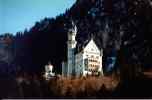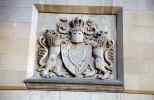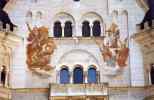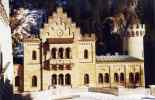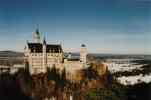Castle Neuschwanstein - a King’s residence
This famous construction, located in the vicinity of Füssen, Allgäu was built on top of a rugged rock above a deep ravine. The octagonal tower is 76 meters high. The idea for this castle was conceived by King Louis II of Bavaria. “I intend to have the old castle ruins by the Pöllat ravine restored, true to the style of the old German castles in which knights resided.” This passage was found in a letter Louis II wrote to his friend Richard Wagner. In the mountains surrounding the castle the King wanted to create an enclave just for himself, allowing him to withdraw and to escape the troubles of everyday life.
On 5th September 1869 the construction began. Under the supervision of Eduard Riedel the portal structure was completed as the first section of the entire complex. In 1872 Georg Dollmann took over the supervision and completed the palais roof in 1881. During this time a score of artists and architects worked on a design for the interior. The various suggestions were turned into detailed plans given to artisans by Julius Hofmann, who was in charge of the project from 1884 on. The King demanded drawings in colour and gold for each detail. The restoring of the castle took up 17 years (1869-1886), the project was never finished, however.
The small castle, formerly occupied by robber barons, was refurbished into a monumental neoromantic structure with obvious resemblance to castle Wartburg located in the vicinity of Eisenach. Especially when examining the palais the similarity becomes evident. This main part of the structure boasts 4 floors containing glamorous halls and rooms, leaving many a visitor speechless. It seems taken right out of the middle of a fairy tail. King Louis II resided in his private premises on the third floor of the palais.
The murals depict scenes from the lay of the Nibelungs, from “Lohengrin”, “Tristan and Isolde”, “Edda”, etc.
Why did the King want to be surrounded by these heroes from Nordic legends and sagas? One event of major influence on the king was Wagner’s Lohengrin, which he saw performed on stage at the age of 16 and by he was both enchanted and shaken. The motif of salvation, which is touched upon in “Lohengrin” and which dominates “Parcival”, had a major influence on the King’s life. Louis II viewed Castle Neuschwanstein as the Parcival’s castle of the Holy Grail. Furthermore, the meeting of Louis II and Richard Wagner turned out to have an unforeseeable impact on the lives of both. King Louis II supported Wagner’s art financially, Wagner’s motifs on the other hand enchanted the King and lead him into dream worlds he tried to realise partially with the construction of Neuschwanstein.
The two rooms between his working room and his living room Louis II had turned into a grotto, including an artificial waterfall illuminated by electric light. His bedroom, too, was decorated in gothic style at immeasurable expense. Allegedly, it took 17 wood carvers and four years to finish.
End of the construction
How was this glamorous building paid for? The funds for the restoring of the castle solely came from the King’s personal assets, which were granted to him by the parliament on an annual basis. After a while, though, shortly before the King’s death, the parliament’s funds were exhausted. King Louis II ordered the construction to be continued - on credit. On the morning of June 12th 1886 a governmental delegation entered the King’s private premises to inform him of his being declared of unsound mind and being placed under guardianship. He was brought to Lake Starnberg where he was supposed to undergo medical treatment. On the next day, the King and his physician, Dr. Gudden, drowned in the lake under mysterious circumstances. The following passage was found in one of the King’s letters to the actress Maria Dahn-Hausmann: “I shall remain a puzzle for all, for myself and the others.” It seems as though he had known, that once upon a time hundreds of legends on his death would come to existence and inspire and give impulses to both the imagination of people and art.

